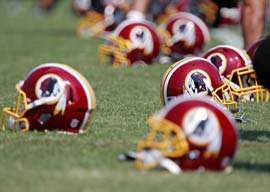
January 14, 2013

I”m guessing that the protesters were trying to make a point something along the lines of, “It is highly unacceptable to engage in rampant stereotyping,” although the message I got was, “It’s extremely funny to engage in rampant stereotyping.”
Regardless of all the protests, Chief Wahoo remains popular among Indians fans, and the Redskins still allow a black man to call himself Chief Zee and wear a headdress at home games. And the Atlanta Braves, after a respite of more than 20 years, have reportedly considered bringing back their “Screaming Indian“ logo for batting-practice caps.
No one makes nearly as big a stink at ethnically stereotypical team names such as the Minnesota Vikings, Boston Celtics, or Notre Dame’s Fighting Irish. And if there’s a pro team whose name should offend American Indians, shouldn”t it be the Dallas Cowboys? My Catholic grade school’s football team was called the Holy Cross Crusaders, which, come to think of it, would be highly offensive to Muslims, although there weren”t any Muslims around to get offended back then.
Then again, the Injuns” descendants don”t seem to be doing nearly as well as those descended from Vikings, Celts, crusaders, and cowboys. But who’s to blame for this? With apparently zero sense of irony, the founder of the Native American Journalists Association blames the persistent use of such team names as “Redskins” on simple “redneck stupidity.” A self-identified Native American woman writes of how Injun-derived team logos are “decidedly not cool” and how they fill her “with shame and rage” and make her feel “sick to my stomach,” ultimately rendering her “too shocked or angered to engage in long dialogues” while she runs around snapping pictures of white people and chiding them for being racists. And “a White girl who dressed up as Pocahontas for Halloween when I was 4″ sees fit to lecture us about how “it’s absolutely never okay to use Native American culture and people as costumes or mascots.”
We are told that such costumes and mascots psychologically traumatize and lower the self-esteem of the so-called natives, which in turn hinders their performance in modern society. In fact, the American Psychological Association issued a 2005 resolution that called for the “Immediate Retirement of American Indian Mascots, Symbols, Images, and Personalities by Schools, Colleges, Universities, Athletic Teams, and Organizations.” The APA argued that such team names and logos create hostile environments that are disrespectful and possibly violate Injuns” civil rights and need to be “eradicated” before this historically underperforming group can reach upward and maximize its innate potential. This past May, the state of Oregon passed a measure that would soon cut funding for any school teams that continued to employ Native American imagery.
Personally, I liked the Injuns more when they were bold and noble warriors than thought-policing whiners. They seemed far more…honorable?
But sure, let’s focus on the kooky mascots and the team names and the foam tomahawks. Let’s never dare mention the gas-huffing and the fetal alcohol syndrome and the drug use and the teen pregnancy. Let’s never ask why these once bold and noble warriors, despite decades of federal payouts and tax breaks, still seem incapable of thriving in a modern technological society. Don”t ever question the wisdom of bringing arrows to a gunfight. Don”t dare search for cultural and possibly even genetic reasons for why the Indians always seem to get the short end of the firestick. It’s obvious that the kooky mascots and the team names and the foam tomahawks are to blame.